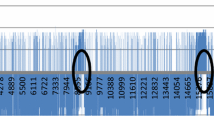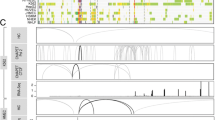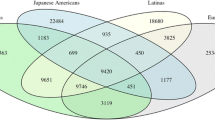Abstract
Familial breast cancer represents up to 5% of all breast cancer cases. Recently, our group has performed a new SNP-based linkage study in 19 non-BRCA1/2 families. We found that a single family was linked to regions in two different chromosomes (11q13 and 14q21), and observed a non-parametric LOD score of 11.5 in both regions. In the present study, we ruled out any possible translocation between the chromosomes. We also used both a panel of STRs and an indirect approach based on HapMap data to narrow down these regions from 28 to 7 Mb in chromosome 11 and from 14.5 to 8.5 Mb in chromosome 14. We performed a mutational screening on candidate genes in 11q13 (NUMA1, FGF3, CCND1, RAD9A, RNF121, FADD and hsa-mir-192), and on FOXA1 in 14q21. Although we have not found any deleterious mutations in the coding region of these genes, data from STR markers confirm 11q13 as a candidate region to contain a breast cancer susceptibility gene.




Similar content being viewed by others
References
Nathanson KL, Wooster R, Weber BL (2001) Breast cancer genetics: what we know and what we need. Nat Med 7:552–556. doi:10.1038/87876
Casey G (1997) The BRCA1 and BRCA2 breast cancer genes. Curr Opin Oncol 9:88–93
Easton D (1997) Breast cancer genes—what are the real risks? Nat Genet 16:210–211. doi:10.1038/ng0797-210
Diez O, Osorio A, Duran M et al (2003) Analysis of BRCA1 and BRCA2 genes in Spanish breast/ovarian cancer patients: a high proportion of mutations unique to Spain and evidence of founder effects. Hum Mutat 22:301–312. doi:10.1002/humu.10260
Walsh T, Casadei S, Coats KH et al (2006) Spectrum of mutations in BRCA1, BRCA2, CHEK2, and TP53 in families at high risk of breast cancer. JAMA 295:1379–1388. doi:10.1001/jama.295.12.1379
Smith P, McGuffog L, Easton DF et al (2006) A genome wide linkage search for breast cancer susceptibility genes. Genes Chromosomes Cancer 45:646–655. doi:10.1002/gcc.20354
Huusko P, Juo SH, Gillanders E et al (2004) Genome-wide scanning for linkage in Finnish breast cancer families. Eur J Hum Genet 12:98–104. doi:10.1038/sj.ejhg.5201091
Thompson D, Szabo CI, Mangion J et al (2002) Evaluation of linkage of breast cancer to the putative BRCA3 locus on chromosome 13q21 in 128 multiple case families from the breast cancer linkage consortium. Proc Natl Acad Sci USA 99:827–831. doi:10.1073/pnas.012584499
Bergman A, Karlsson P, Berggren J et al (2007) Genome-wide linkage scan for breast cancer susceptibility loci in Swedish hereditary non-BRCA1/2 families: suggestive linkage to 10q23.32–q25.3. Genes Chromosomes Cancer 46:302–309. doi:10.1002/gcc.20405
Pharoah PD, Antoniou A, Bobrow M et al (2002) Polygenic susceptibility to breast cancer and implications for prevention. Nat Genet 31:33–36. doi:10.1038/ng853
Honrado E, Osorio A, Milne RL et al (2007) Immunohistochemical classification of non-BRCA1/2 tumors identifies different groups that demonstrate the heterogeneity of BRCAX families. Mod Pathol 20:1298–1306. doi:10.1038/modpathol.3800969
Gonzalez-Neira A, Rosa-Rosa JM, Osorio A et al (2007) Genomewide high-density SNP linkage analysis of non-BRCA1/2 breast cancer families identifies various candidate regions and has greater power than microsatellite studies. BMC Genomics 8:299. doi:10.1186/1471-2164-8-299
Abecasis GR, Cherny SS, Cookson WO et al (2002) Merlin—rapid analysis of dense genetic maps using sparse gene flow trees. Nat Genet 30:97–101. doi:10.1038/ng786
Caldes T, de la Hoya M, Tosar A et al (2002) A breast cancer family from Spain with germline mutations in both the BRCA1 and BRCA2 genes. J Med Genet 39:e44. doi:10.1136/jmg.39.8.e44
Liede A, Rehal P, Vesprini D et al (1998) A breast cancer patient of Scottish descent with germ-line mutations in BRCA1 and BRCA2. Am J Hum Genet 62:1543–1544. doi:10.1086/301889
Buness A, Kuner R, Ruschhaupt M et al (2007) Identification of aberrant chromosomal regions from gene expression microarray studies applied to human breast cancer. Bioinformatics 23:2273–2280. doi:10.1093/bioinformatics/btm340
Loo LW, Grove DI, Williams EM et al (2004) Array comparative genomic hybridization analysis of genomic alterations in breast cancer subtypes. Cancer Res 64:8541–8549. doi:10.1158/0008-5472.CAN-04-1992
Paterson AL, Pole JC, Blood KA et al (2007) Co-amplification of 8p12 and 11q13 in breast cancers is not the result of a single genomic event. Genes Chromosomes Cancer 46:427–439. doi:10.1002/gcc.20424
Acknowledgments
We thank David Rodriguez from the Genomics Unit at the Spanish National Cancer Research Centre, for his technical support in sequencing. We also thank Lorenzo Melchor and Ricardo Ramires from the Human Genetics Group for their scientific support and advice. This study has been funded by project FIS-04-2240 from the Fondo de Investigaciones Sanitarias, and by the Asociación Española Contra el Cáncer. JMRR Grant sponsor: Ministerio de Educacion y Ciencia, FPU AP-2005-1720.
Author information
Authors and Affiliations
Corresponding author
Electronic supplementary material
Below is the link to the electronic supplementary material.
Rights and permissions
About this article
Cite this article
Rosa-Rosa, J.M., Pita, G., González-Neira, A. et al. A 7 Mb region within 11q13 may contain a high penetrance gene for breast cancer. Breast Cancer Res Treat 118, 151–159 (2009). https://doi.org/10.1007/s10549-009-0317-1
Received:
Accepted:
Published:
Issue Date:
DOI: https://doi.org/10.1007/s10549-009-0317-1




